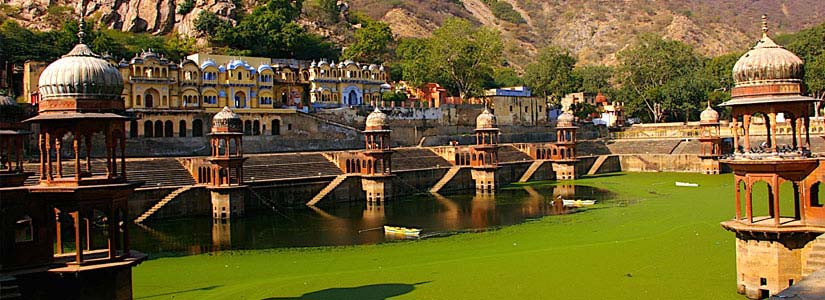
The city of Alwar was built by the Kachawa Rajput of Macheri - Rao Pratap Singh in 1775. For a brief while the Marathas as well as the British took possession of Alwar. In the year 1949, Alwar was amalgamated with the state of Rajasthan.Alwar is about 145 km away from the pink city of Jaipur and 170 km away from Delhi. Visit the Bala Quila. See Vinay Vilas Mahal, which was built in the 18th century. The palace showcases an excellent mix of Rajput and Mughal architecture. Apart of the palace has been converted into a museum. Alwar has a Government Museum that houses a perfect collection of Rajput and Mughal paintings, weapons and other artifacts.
There is a museum inside the palace and on display at the museum are authentic miniature paintings, rare manuscripts, ivory items, and a rich collection of weapons. The museum also has in its possession 700 rare manuscripts in Hindi, Sanskrit, Arabic and Persian language. The 24 m Bhagavat and Arabic Koran are some of the museums priceless artifacts and national treasures.
On the outskirts of Alwar is the magnificent Vijay Mandir Palace, which was built way back in 1918. The palace is located in a rather picturesque setting on the banks of the shimmering Vijay Sagar Lake. There are 105 grandiose rooms in all at the palace and members of the royal family still live in this majestic palace. One has to seek prior permission from the authorities to enter inside the palace.
You can find a train to Alwar from all the major cities of India. From Delhi, you can catch Shatabdi Express, Intercity Express and Mandore Express. Fairy Queen Express, the train that makes your trip a fairy tale experience, includes Alwar on its itinerary list.

Fort, which bound the people to watch its magnetic beauty, towering on a hill dominating the town, is the BALA QILA (young fort). Amazing fortifications surround the NIKUMBHA MAHAI PALACE at the top, which has graceful Bengal caned marble columns and delicate latticed balconies. The fort is 595 mts. above the city, and extends about 5 Kms from north and south and 1.6 Kms from east and west.
The fort has 15 large and 51 small towers, which contains 446 loopholes for the musketry, its eight towers all around defend it. The most magnificent were 3,599 kanguras, each containing two loopholes for musketry. The fort can be entered through six gates, namely JAI POL, SURAJ POL, LAXMAN POL, LAXMAN POL, CHAND POL, KRISHAN POL and ANDHERI GATE.

The centopath reflects Indo-Islamic style of architecture. The upper portion in marble with columned pavilions and domed arches with exquisite floral tracery rests over the pillared red sand stone story. Mythological and court scenes in fading gold leaf painting and sculpture adorn the ceiling. The memorial is rated as one of the finest in its class. The picturesque SAGAR is concrete catchments with a pattern of stairs and tiny kiosks in perfect symmetry along the sides.

The metalled road commencing from the Sanctuary gate ends at this temple dedicated to LORD HUNUMAN. This backed by the delightful sight of Pandupol or Pandu gate where a cascading spring emerges from hard and compact rocks. Legend has it that the Pandava brother took refuge here during their exile.